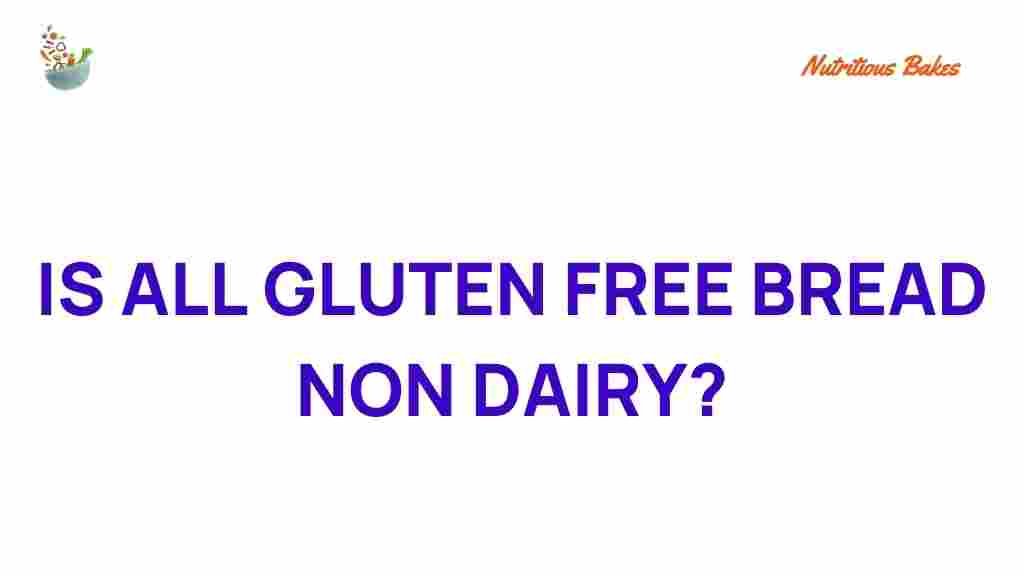Is All Gluten-Free Bread Truly Dairy-Free? Unpacking the Myths
In recent years, gluten-free diets have gained significant popularity, leading to a surge in gluten-free products on the market. Among these, gluten-free bread is a staple for many who are sensitive to gluten or have celiac disease. However, a common question arises: is all gluten-free bread truly dairy-free? This article delves into the myths surrounding gluten-free bread, exploring its ingredients, nutrition, and how it fits into various dietary choices.
Understanding Gluten and Dairy
Before we dive into the specifics of gluten-free bread, it’s essential to understand what gluten and dairy are. Gluten is a protein found in wheat, barley, and rye, which can cause adverse reactions in individuals with gluten intolerance or celiac disease. Dairy, on the other hand, refers to products made from the milk of mammals, which can also trigger allergies or intolerances in some people.
What Makes Bread Gluten-Free?
Gluten-free bread is made using alternative grains and flours that do not contain gluten. Common gluten-free ingredients include:
- Rice flour
- Almond flour
- Coconut flour
- Oat flour
- Chickpea flour
These ingredients provide the necessary structure and texture to gluten-free bread, but they can also be combined with various other components, some of which may contain dairy.
Are All Gluten-Free Breads Dairy-Free?
The short answer is no. Not all gluten-free bread is dairy-free. While many brands specifically market their products as gluten-free and dairy-free, there are several factors that can introduce dairy into gluten-free bread:
- Added Ingredients: Some gluten-free breads contain dairy products like milk powder, butter, or cheese to enhance flavor and texture.
- Cross-Contamination: Gluten-free breads may be produced in facilities that also process gluten-containing products and dairy, leading to potential cross-contamination.
- Labeling Practices: Food labels can sometimes be misleading, and terms like “natural flavors” may include dairy derivatives.
When shopping for gluten-free bread, it’s crucial to carefully read food labels to determine if a product is also dairy-free. Here are some tips for navigating food labels:
- Look for Certification: Seek products that are certified gluten-free and dairy-free by reputable organizations.
- Check the Ingredients List: Always read the ingredients list for any dairy components, such as milk, butter, or cream.
- Allergen Statements: Pay attention to allergen statements that indicate potential cross-contamination with dairy.
Popular Myths About Gluten-Free and Dairy-Free Bread
As with any dietary trend, numerous myths surround gluten-free and dairy-free bread. Here are some common misconceptions:
Myth 1: All Gluten-Free Bread is Healthy
This is a significant misconception. While gluten-free bread can be part of a healthy diet, many commercially available options are high in sugars and refined flours, which can impact overall nutrition.
Myth 2: Gluten-Free Bread is Automatically Dairy-Free
As discussed, not all gluten-free bread is dairy-free. It’s essential to check labels carefully to avoid unwanted ingredients.
Myth 3: Gluten-Free Bread Lacks Nutritional Value
While some gluten-free breads may be low in fiber and nutrients, many brands now use whole grains and seeds to create more nutritious options. Look for options that include high-fiber ingredients.
Making Your Own Gluten-Free, Dairy-Free Bread
If you’re concerned about the ingredients in store-bought gluten-free bread, consider making your own at home. Here’s a simple step-by-step process:
Ingredients
- 2 cups gluten-free flour blend (rice flour, almond flour, or a combination)
- 1 tablespoon baking powder
- 1 teaspoon salt
- 2 tablespoons olive oil or coconut oil
- 1 cup dairy-free milk (almond milk, coconut milk, etc.)
- 1 tablespoon honey or maple syrup (optional)
- 1 teaspoon apple cider vinegar
Instructions
- Preheat your oven to 350°F (175°C).
- In a large bowl, mix the gluten-free flour, baking powder, and salt.
- Add the oil, dairy-free milk, honey (if using), and apple cider vinegar. Mix until well combined.
- Pour the batter into a greased loaf pan.
- Bake for 35-40 minutes or until a toothpick inserted into the center comes out clean.
- Let cool before slicing.
Troubleshooting Tips for Homemade Bread
When making gluten-free, dairy-free bread, you may encounter some challenges. Here are some troubleshooting tips:
- If the bread is too dense, try adding more liquid or increasing the baking powder.
- If the bread is crumbly, consider adding eggs or a flaxseed egg for better binding.
- If the crust is too hard, cover the bread with foil for part of the baking time.
Nutrition Considerations
When assessing gluten-free and dairy-free bread options, consider the following nutritional aspects:
- Fiber Content: Look for breads that include whole grains or seeds to boost fiber intake.
- Protein: Incorporate protein-rich ingredients such as nut flours or seeds to enhance nutritional value.
- Added Sugars: Be cautious of breads with high sugar content, as these can negate health benefits.
Health Benefits of Going Gluten-Free and Dairy-Free
Choosing gluten-free and dairy-free options can offer several health benefits, particularly for those with specific dietary needs:
- Improved Digestion: For those with gluten intolerance or dairy sensitivity, eliminating these ingredients can lead to better digestive health.
- Increased Energy Levels: Removing gluten and dairy from the diet can reduce inflammation and improve overall energy levels.
- Better Skin Health: Some individuals notice improvements in skin conditions like eczema or acne when they eliminate gluten and dairy.
Conclusion
In summary, while many gluten-free breads are dairy-free, it’s important to be cautious and informed. Not all gluten-free products fit the dairy-free label, and many can contain hidden dairy ingredients. By educating yourself about food labels, knowing the myths surrounding gluten-free bread, and possibly making your own at home, you can enjoy delicious and nutritious bread that aligns with your dietary choices.
For more information on gluten-free diets and recipes, visit this resource. Additionally, consider exploring options from trusted brands that clearly state their ingredients and dietary certifications.
Ultimately, making informed choices about gluten-free and dairy-free bread can lead to healthier eating habits and improved well-being.
This article is in the category Ingredients and created by NutritiousBakes Team
